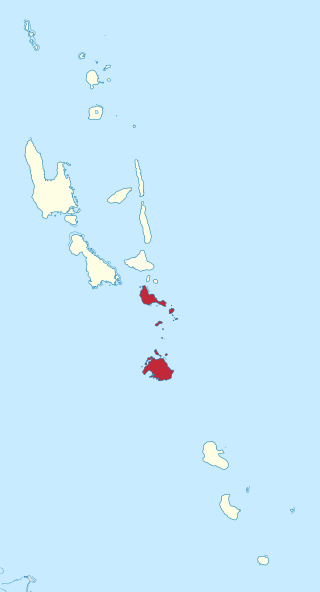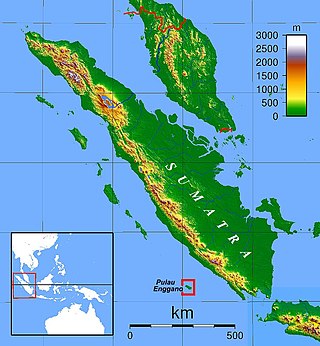Related Research Articles

Samoan is a Polynesian language spoken by Samoans of the Samoan Islands. Administratively, the islands are split between the sovereign country of Samoa and the United States territory of American Samoa. It is an official language, alongside English, in both jurisdictions. It is widely spoken across the Pacific region, heavily so in New Zealand and also in Australia and the United States. Among the Polynesian languages, Samoan is the most widely spoken by number of native speakers.
Rapa Nui or Rapanui, also known as Pascuan or Pascuense, is an Eastern Polynesian language of the Austronesian language family. It is spoken on Easter Island, also known as Rapa Nui.
The Nafsan language, also known as South Efate or Erakor, is a Southern Oceanic language spoken on the island of Efate in central Vanuatu. As of 2005, there are approximately 6,000 speakers who live in coastal villages from Pango to Eton. The language's grammar has been studied by Nick Thieberger, who has produced a book of stories and a dictionary of the language.

Shefa is one of the six provinces of Vanuatu, located in the center of the country and including the islands of Epi and Efate and the Shepherd Islands. The province's name is derived from the initial letters of SHepherd and EFAte. It has a population of 78,723 people and an area of 1,455 km2. Its capital is Port Vila, which is also the capital of the nation.
The Nukuoro language is a Polynesian Outlier language, spoken by about 1,200 people on Nukuoro Atoll and on Pohnpei, two islands of Pohnpei State within the Federated States of Micronesia. Nukuoro is a remote coral atoll with a population of about 150, where the primary language is Nukuoro. An additional several hundred Nukuoro speakers live in Kolonia, Pohnpei, with smaller diaspora communities elsewhere in Micronesia and in the United States. Most Nukuoro speakers, particularly those that live away from Nukuoro Atoll, are multilingual in Pohnpeian and/or English; some older Nukuoro speakers also know German or Japanese.
Sakao is an Oceanic language spoken on the northeast horn of Espiritu Santo, Vanuatu.
Mwotlap is an Oceanic language spoken by about 2,100 people in Vanuatu. The majority of speakers are found on the island of Motalava in the Banks Islands, with smaller communities in the islands of Ra and Vanua Lava, as well as migrant groups in the two main cities of the country, Santo and Port Vila.
Sa or Saa language is an Austronesian language spoken in southern Pentecost Island, Vanuatu. It had an estimated 2,500 speakers in the year 2000.
Apma is the language of central Pentecost island in Vanuatu. Apma is an Oceanic language. Within Vanuatu it sits between North Vanuatu and Central Vanuatu languages, and combines features of both groups.
Araki is a nearly extinct language spoken in the small island of Araki, south of Espiritu Santo Island in Vanuatu. Araki is gradually being replaced by Tangoa, a language from a neighbouring island.
The Wuvulu-Aua language is an Austronesian language which is spoken on the Wuvulu and Aua Islands and in the Manus Province of Papua New Guinea.
The Anuta language is a Polynesian Outlier language from the island of Anuta in the Solomon Islands. It is closely related to the Tikopia language of the neighboring island of Tikopia, and it bears significant cultural influence from the island. The two languages have a high degree of mutual intelligibility, although Anutans can understand Tikopians better than the reverse.
Kokota is spoken on Santa Isabel Island, which is located in the Solomon Island chain in the Pacific Ocean. Santa Isabel is one of the larger islands in the chain, but it has a very low population density. Kokota is the main language of three villages: Goveo and Sisigā on the North coast, and Hurepelo on the South coast, though there are a few speakers who reside in the capital, Honiara, and elsewhere. The language is classified as a 6b (threatened) on the Graded Intergenerational Disruption Scale (GIDS). To contextualize '6b', the language is not in immediate danger of extinction since children in the villages are still taught Kokota and speak it at home despite English being the language of the school system. However, Kokota is threatened by another language, Cheke Holo, as speakers of this language move from the west of the island closer to the Kokota-speaking villages. Kokota is one of 37 languages in the Northwestern Solomon Group, and as with other Oceanic languages, it has limited morphological complexity.
Raga is the language of northern Pentecost Island in Vanuatu. Like all Vanuatu languages, Raga belongs to the Oceanic subgroup of the Austronesian languages family. In old sources the language is sometimes referred to by the names of villages in which it is spoken, such as Bwatvenua (Qatvenua), Lamalanga, Vunmarama and Loltong.
Hiw is an Oceanic language spoken on the island of Hiw, in the Torres Islands of Vanuatu. With about 280 speakers, Hiw is considered endangered.

The Enggano language, or Engganese, is an Austronesian language spoken on Enggano Island off the southwestern coast of Sumatra, Indonesia.
Emae, Emwae or Mae language, is a Polynesian outlier language of Vanuatu.
Southeast Babar is an Austronesian language spoken on Babar Island in South Maluku, Indonesia.
Neverver (Nevwervwer), also known as Lingarak, is an Oceanic language. Neverver is spoken in Malampa Province, in central Malekula, Vanuatu. The names of the villages on Malekula Island where Neverver is spoken are Lingarakh and Limap.

Ifira is an offshore island of Efate, located in Shefa Province of Vanuatu in the Pacific Ocean.
References
- Clark, Ross (1 June 2011). "Mele-Fila". In Tryon, Darrell T. (ed.). Comparative Austronesian Dictionary: An Introduction to Austronesian Studies. Walter de Gruyter. pp. 947–950. doi:10.1515/9783110884012.2.947. ISBN 978-3110884012.